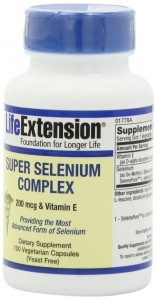 Selenium for Graves’ Disease/ Thyroid Eye Disease/ Thyroid Antibodies
Selenium for Graves’ Disease/ Thyroid Eye Disease/ Thyroid Antibodies
by Svetla Bankova
This is not a new information in fact, but I am mentioning it here because there was just another scientific research about Thyroid eye disease and Selenium that I feel I should share with you all.
 Recently study titled “Selenium and the course of mild Graves’ orbitopathy” was conducted by the Department of Endocrinology and Metabolism, University of Pisa, Pisa, Italy.
Recently study titled “Selenium and the course of mild Graves’ orbitopathy” was conducted by the Department of Endocrinology and Metabolism, University of Pisa, Pisa, Italy.
What happened: They carried out a randomized, double-blind, placebo-controlled trial to determine the effect of selenium (an antioxidant agent) or pentoxifylline (an antiinflammatory agent) in 159 patients with mild Graves’ orbitopathy. The patients were given selenium (100 μg twice daily), pentoxifylline (600 mg twice daily), or placebo (twice daily) orally for 6 months and were then followed for 6 months after treatment was withdrawn. Primary outcomes at 6 months were evaluated by means of an overall ophthalmic assessment, conducted by an ophthalmologist who was unaware of the treatment assignments, and a Graves’ orbitopathy-specific quality-of-life questionnaire, completed by the patient. Secondary outcomes were evaluated with the use of a Clinical Activity Score and a diplopia score.
CONCLUSIONS made by the scientists: Selenium administration significantly improved quality of life, reduced ocular involvement, and slowed progression of the disease in patients with mild Graves’ orbitopathy (you read it as Thyroid Eye Disease).
Another older, but still relevant information on “selenium for Graves Disease” as well:
On June 22, 2001 Dr. Barbara Gasnier reported the findings at the 83rd Annual Meeting of the Endocrine Society in Denver, Colorado that selenium supplementation may prevent progression of autoimmune thyroid disease, especially during the onset of the disease. According to the researchers, selenium deficiency appears to contribute to the development and maintenance of autoimmune thyroiditis because of its effect on the function of selenium-dependent enzymes, which can modulate the immune system.
Selenium for graves disease (supplementation with 200mcg of sodium selenite) may improve the inflammatory activity seen in patients with autoimmune thyroiditis, but whether this effect is specific for autoimmune thyroiditis or may also be effective in other organ-specific autoimmune diseases remains to be investigated. Selenium supplementation may lower free radical activity, which contributes to inflammation.
It appears that taking selenium without iodine will result in a decrease in production of Thyroxine (T4), although there may be an initial transient increase in T4 to T3 conversion and hence higher T3 and seemingly worse hyperthyroidism.
Bottom line: Selenium may be helpful for both- hyperthyroidism and thyroid eye disease (mild, they say, but who knows). I know that almost any laboratory can measure it if you need any vitamins and supplements. Better check that as well.
How it is taken: I am not a pro here, because I personally have never taken that supplement, (actually I am going today to the store and buy some) but I just did my homework on researching the subject. This is what it says:
Conclusion: Taking 200 mg/ daily Selenium Selenite may also dramatically decrease the Thyroid Antibodies ( TPO so called). Also, if combined with Vitamin E, as in the product below this post, it’s even a better option.
In another study I found in Clinica Chimica Acta (2004:341:55-63), researchers found that antioxidants, especially those containing selenium, had a beneficial effect in the treatment of Graves Disease. From the abstract: “The effect of supplementation with a fixed combination of antioxidants (vitamins C and E, beta-carotene and selenium) was monitored on the speed of attaining euthyroidism in a group of patients with Graves’ disease, treated with methimazole. Methods: The activity of glutathione peroxidase in whole blood and the concentrations of selenium, pituitary and thyroid hormones in serum were measured, prior to commencement of therapy and after 30 and 60 days. Results: Patients who received supplementation with antioxidants in addition to therapy with methimazole (Group A, n=29) attained euthyroidism faster than the patients treated with only methimazole (Group B, n=28). The concentration of selenium in the serum of patients in Group A increased significantly during treatment (p<0.001), while there was no statistically significant change in the patients in Group B. The concentration of selenium in the serum between the groups differed statistically significantly 30 days (p<0.05) and 60 days (p<0.01) after the commencement of therapy. Activity of glutathione peroxidase in whole blood increased during treatment in both groups of patients. However, a statistically more significant increase occurred in Group A compared to Group B, 30 days after the commencement of therapy (p<0.01).”
 Bottom line: Taking selenium + other antioxidants like Vitamin C, Vitamin E, Beta carotene, Vitamin A) may dramatically increase the speed of recovery from hyperthyroidism. As noted by Dr. Russell Blaylock it has many effects on nutrition and behavior.
Bottom line: Taking selenium + other antioxidants like Vitamin C, Vitamin E, Beta carotene, Vitamin A) may dramatically increase the speed of recovery from hyperthyroidism. As noted by Dr. Russell Blaylock it has many effects on nutrition and behavior.
Don’t rush to the store now to buy all these Vitamins, especially Selenium- you may check with your doctor first and read the contraindications carefully. Overdosing with selenium can be even more dangerous, than the lack of it.
Reference:
Serum Selenium Levels in Patients with Remission and Relapse of Graves Disease , Department of Endocrinology, Diabetes and Rheumatology, University Hospital Duesseldorf, Duesseldorf, Germany. Med Chem. 2007 May;3(3):281-4. Author(s): Tina Wertenbruch, Holger S. Willenberg, Cornelia Sagert, Thi-Bang-Tam Nguyen, Maryam Bahlo, Joachim Feldkamp, Claus Groeger, Derik Hermsen, Werner A. Scherbaum and Matthias Schott.
